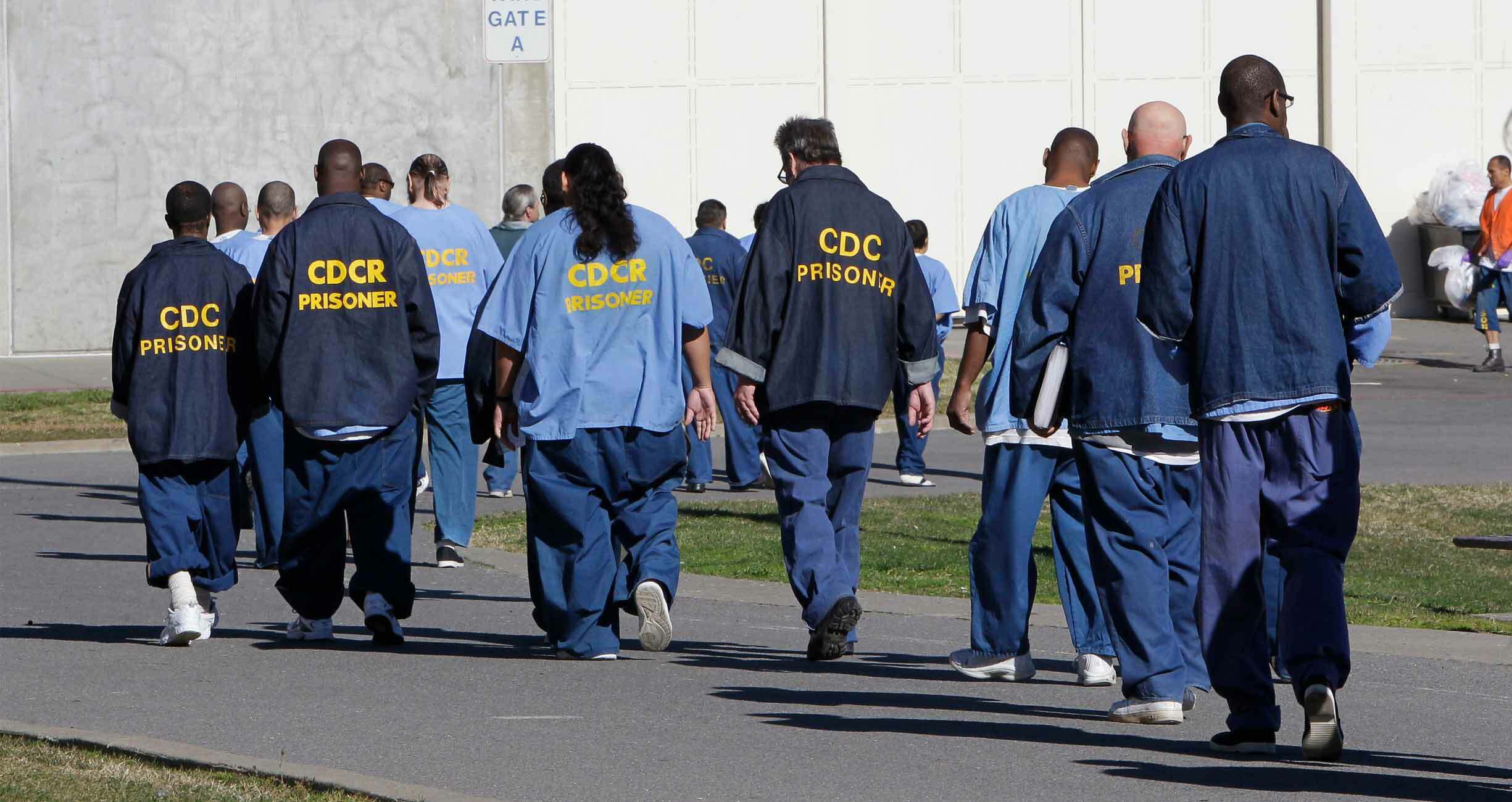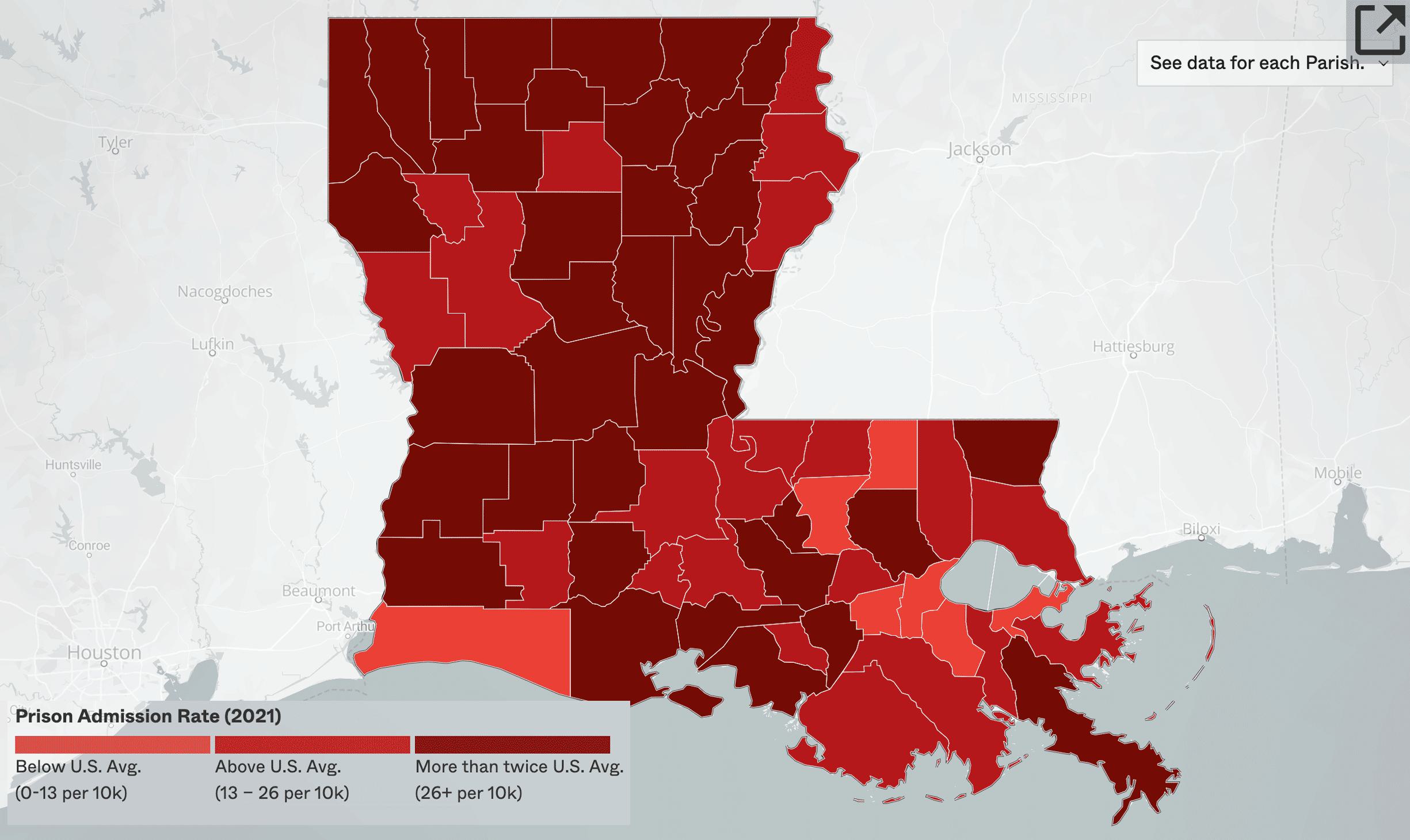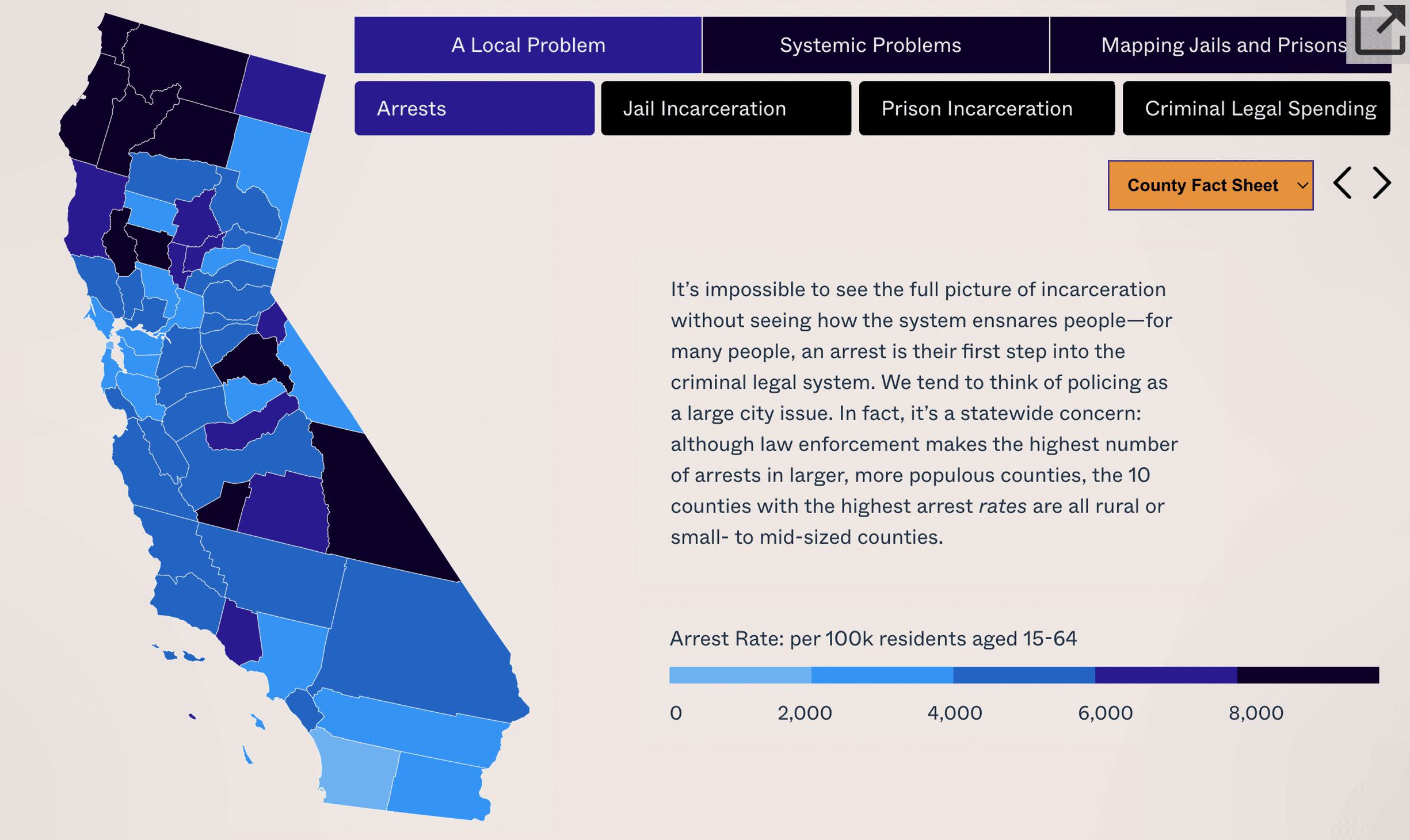New Data Hubs Show Local Impact of Mass Incarceration in California and Louisiana

There is growing consensus that mass incarceration does not make communities safer. But the drivers and markers of it—from local budgets to jails and prisons—are infrequently studied and even less often understood. Jails and prisons shape local communities across the country: they influence elections, perpetuate often-brutal histories, and limit the economic possibilities for families and communities. Dismantling mass incarceration requires action at the local level, which demands an understanding of local reality.
While data that describes the scale of mass incarceration in each state, and nationwide, is readily available, data that describes the criminal legal system at the local level is often difficult to access. Unpacking the resources dedicated to the criminal legal system, and the impact of law enforcement and incarceration on the community, is hard to find. In some states, such as Louisiana, data only exists in PDFs of government reports—or doesn’t exist at all. And in others, such as California, there are detailed datasets available on government websites, but making sense of them requires data analysis skills. This context makes it difficult to understand, let alone confront, the problem of mass incarceration at the scale on which it is felt by communities. Two new data hubs released by Vera aim to change that. The two tools—Louisiana Locked Up and California: The State of Incarceration—compile detailed data on county- and parish-level incarceration rates, jail and prison geography, immigration detention facilities, and spending. In consolidating data for the public, the hubs provide advocates, journalists, and legislators with a clear articulation of the problem of mass incarceration, as well as a possible roadmap for advocacy.
“To end mass incarceration, we must understand its drivers and the solutions that work to build safe, thriving communities,” said Insha Rahman, Vera’s vice president of advocacy and partnerships. “For too long, the data has not been readily accessible to those who need it most. We are excited to launch the Louisiana and California data hubs to provide timely information about budgets, spending, jails, and prisons—county by county, and statewide. Our hope is that policymakers, advocates, and the media harness this data to influence the public discourse and compel the policy change our communities need and deserve for more safety and justice.”
Louisiana Locked Up

Louisiana has the highest pretrial incarceration rate in the nation, jailing people who are presumed innocent at a rate twice the national average. It also has the second highest imprisonment rate in the country.
The new data hub makes clear that mass incarceration is not confined to any one corner of Louisiana. Louisiana’s prison admission rate and pretrial incarceration rate is greater than the national average in nearly every parish and more than twice the national average in most of them. Prior to the release of the data hub, this parish-level data was buried in obscure government reports.
"For decades, data on incarceration in Louisiana has been practically inaccessible to the people, especially in those communities hurt most by our state’s incarceration policies. If we are to implement effective policy solutions to improve public safety in our communities, we need clear, accessible, and accurate information,” said Dr. Kim Mosby, Louisiana associate director of research at Vera. “The data hub shows how every community contributes to the problem of mass incarceration and sheds much-needed light on the areas where we can improve.”
Beyond making the data more accessible, the new hub also points to how Louisiana’s incarceration trends came to be. Vera analysis shows that the places with the most outsized jails relative to population often have the highest pretrial detention rates and send people to prison at the highest rates—in other words, if a jail is built, the state will fill it. The inverse is also true: when Hurricane Katrina destroyed the Orleans Parish Prison, the city of New Orleans rebuilt the jail with 6,000 fewer jail beds, thanks to engaged community advocacy. By 2019, the parish’s pretrial population had declined by 75 percent and the total jail population had fallen by more than 80 percent, all while the city’s crime rate declined. But during this period, Sheriffs across the state added 14,000 beds to their jails—thereby expanding statewide jail capacity and catalyzing the expansion of pretrial incarceration in other parishes.
Law enforcement is incentivized to fill the 33,800 beds it operates, too: the state pays local jails to hold people serving a state prison sentence, and more than half of those held on a prison sentence are detained in local jails. This arrangement saves the state money and lines local sheriff’s coffers, but being held in local jails deprives incarcerated people of services, like education and vocational training, that are more often found in prisons.
Louisiana Locked Up also makes clear that mass incarceration is a legacy of slavery that defines life in the state today. The data hub allows users to compare today’s carceral footprint to the 1853 plantation footprint and study the geographical overlap.
California: The State of Incarceration

On any given day, California holds nearly 160,000 people in its jails and prisons. Its most populous county, Los Angeles, has the largest jail population in the country. Despite its reputation as a liberal bastion, California is one of the epicenters of mass incarceration.
The data hub puts that fact under a microscope, unpacking the strain California’s incarceration policies place on the people and budgets of each of the state’s 58 counties. The data hub shows that the state spends a staggering amount on incarceration. In 2011, the United States Supreme Court ordered California to reduce the unconstitutional overcrowding in its prisons. Since then, prison populations have fallen in 52 counties, and jail populations have decreased by 16 percent. But county spending on detention has increased by 20 percent.
The data hub highlights two significant drivers of mass incarceration: the growing number of incarcerated people with mental health needs and pretrial detention. Forty-four percent of people in California’s jails have a mental health condition, and the percentage of people with mental health treatment needs has increased over the last decade. And 75 percent of people held in jails statewide are awaiting trial and have not been convicted of a crime. Pretrial detention exposes them to enormous harms: even a single day in jail makes people more likely to lose employment or housing and increases their chance of being rearrested. And California jails are themselves dangerous, violent, and sometimes deadly. But most jail and prison dollars in California are likely going toward jail staff salaries and benefits instead of education and vocational, diversion, or mental health programs to mitigate the harms of incarceration.
And while Los Angeles is home to the largest jail population, the data makes clear that mass incarceration is a statewide issue. In fact, the three highest incarceration rates in the state belong to rural counties. More robust advocacy, informed by data included in the hub, can make a massive difference in these communities.
“Mass incarceration robs our communities of resources. Not only are far too many of our neighbors held behind bars, but the cost of their incarceration is the single biggest line item in most counties in our state, meaning less money for schools, for transit, for public spaces and programs that keep us safe,” said Michelle Parris, program director of Vera California. “By consolidating this data and making it accessible, we hope communities across the state can have conversations about their priorities with a real picture of just how much we lose if we double down on the same failed policies.”
Advocates are ready to use the tool to build a stronger movement, too. Ambrose Brooks S is an organizer with Care First California, a statewide coalition working to replace the carceral system with resources that build safety. They say that the tool will serve as an entry point for people to join the broader movement, and to push legislators into action.
“We're organizers, not data scientists, and Vera has done a ton of the heavy lifting to not only get the data but make it into a creative visualization of the data that will also help bring people into the work,” Brooks S said. “You can't run from data. You just literally can't, it's right there in front of you. So, it could [also] be a reality check for some legislators.”
